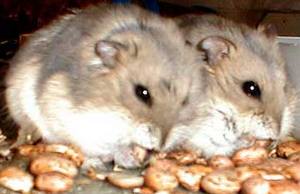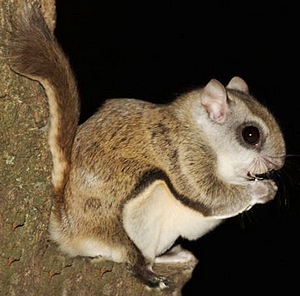Hamsters

Habitat
hamsters are solitary animals and only come together for mating. In the wild, male common and grey hamsters visit the burrows of females and are driven out after mating. In captivity, golden hamsters have to be separated after mating, otherwise the female may kill the male. The gestation period of the common hamster is 19 - 20 days, that of the golden hamster 15 days. Some four to twelve naked and blind young are born in a nest chamber in the burrow. Their eyes open at two weeks old and by this time they have a thick coat of fur. The young hamsters are weaned quickly, at 3 - 4 weeks, and leave their mother shortly after. A mother hamster is very maternal, and, if danger threatens, she will carry her babies away, either by putting them into her cheek pouches or laying them across the toothless area of her jaws. A female hamster may have two or three litters each year.
Lifespan
hamsters are solitary animals and only come together for mating. In the wild, male common and grey hamsters visit the burrows of females and are driven out after mating. In captivity, golden hamsters have to be separated after mating, otherwise the female may kill the male. The gestation period of the common hamster is 19 - 20 days, that of the golden hamster 15 days. Some four to twelve naked and blind young are born in a nest chamber in the burrow. Their eyes open at two weeks old and by this time they have a thick coat of fur. The young hamsters are weaned quickly, at 3 - 4 weeks, and leave their mother shortly after. A mother hamster is very maternal, and, if danger threatens, she will carry her babies away, either by putting them into her cheek pouches or laying them across the toothless area of her jaws. A female hamster may have two or three litters each year.
Flying squirrel

areas. Den sites include tree cavities and witches' brooms. Tree cavities are most numerous in old forests where wood rot, frost cracking, woodpeckers, and carpenter ants have created or enlarged cavities. Witches' brooms, clumps of abnormal branches caused by tree rust diseases, are the most common denning sites of flying squirrels in Interior Alaska. About November or December, when temperatures begin to drop sharply, flying squirrels move out of cavities and into brooms. In the coldest periods of winter, they form aggregations of two or more individuals in the brooms and sleep in torpor.
Feeding areas preferred by flying squirrels contain fungi (mushrooms and truffles), berries, and tree lichens and may be in either young or old forests. Dried fungi cached in limbs by red squirrels are sometimes stolen by flying squirrels.
Flying squirrels probably get water from foods they eat and rain, dew, and snow. Constant sources of free water (lakes, ponds, and watercourses) do not appear to be a stringent habitat requirement.
In a year's time, a flying squirrel in Interior Alaska may use as many as 13 different den trees within 19.8 acres (8 ha). On a night foray, a squirrel may travel as far as 1.2 miles (2 km) in a circular route and be away from its den tree for up to 7 hours. It may change den trees at night and move to different ones more than 20 times over a year, staying in each for a varying numbers of days. Den trees with brooms are used more than twice as much as trees with cavities.
Fairly dense, old closed-canopy forests with logs and corridors of
trees (especially conifers) that are spaced close enough to glide
between are needed for cover from predators. High quality flying
squirrel habitat can be a community mosaic of small stands of
varying age classes in which there is a mix of tall conifers and
hardwoods. Part of the mosaic must be old coniferous forest with
den trees containing witches' brooms, woodpecker cavities, and
natural cavities for nesting sites. Riparian zones provide
excellent habitat in all coniferous forest associations.
Diet
In the wild, there are 2 basic breeding periods for squirrels. They are from February to March, and June to July (except for the Flying Squirrels, which is only from January to March). For most of the different types, several males will go after a female in season, but only one of them will end up mating with her.
All baby squirrels are born blind and naked. Their eyes start opening usually when they are a few weeks old, and their fur starts growing within a week. The young usually stay with their mothers for at least a month after they are weaned to learn how to find food (and glide in the case of flying squirrels), before they become completely independent.
Most species are essentially the same in their breeding statistics, but they are broken up according to three common species below:
Life span
This squirrel is nocturnal (most active at night). It has a life span of about 5 years in the wild, and about 13 years in captivity. Flying squirrels live ...